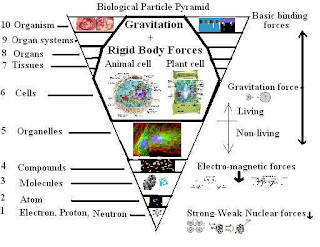Institute for Intrinsic Gravitation Biology (i3GB)
Guwahati, India @ under creative liscence
Email: selfgravity@gmail.com
Abstract
"Self gravitation bio" is the study of the effects of self gravity has on the biomass of living organism and impact of associated intricacies for metabolic energy working against gravity as well as buffer mechanism in opposition in surrounding inert infrastructure to sustain pressure difference for separating confluence effects of intrinsic and extrinsic gravity on life of organisms. Biophysical Society has cataloged with nomenclature for new biophysics discipline ‘Self Gravitation Bio’ in 2008.

Fig 1. At cell level, nucleiod, nucleus ornucleolisde , being much denser than other neighboring macromolecules tries to remain in the centre due to central attraction of self gravity. Under 3-D condition, buyoant force of cytoplasmic fluid buffers the macromolecules from stronger external gravitational force of earth or intertial matters which can be designated as 'metabolic inert infrustructure'. Metabolic energy centres like mitochondria, chloroplast lies at the periphery (away from the central axis) where pull of self gravity is minimum. The metabolic energy therefore can support the life functions of the living mass with less effort on working against the inward force of self gravity as well as against the force of external attraction of extrinsic gravity.
Without ‘mass’ living organism cannot be imagined. Ever-present force of gravity is the building block of the universe that attracts ‘mass’ either as self or mutual gravity. Self gravity compresses accumulated materials to a point at its center. Invisible unsurpassed binding action of self gravity seems prominent in biological particle hierarchy in non-Newtonian state, with accumulation of bio 'mass’ at the level of organelles or cell in the particle hierarchy (sub-atom, atom, molecule, compound, organelles, cells, tissue, organ, organ system, and organism).

Self gravity in biology can not be ignored
Biological masses are under the influence of both intrinsic and extrinsic forces of gravity, as can be distinct as self gravity as well as mutual gravity respectively. The force of self-gravity can be expressed as F = G[m^2/λ^2], where λ is the wavelength of the particle at quantum stage. The force of mutual gravity at classical stage on the other hand can be expressed by F = G[m^2/r^2], where r is the radial distance to the center of gravity of a uniform density spherical mass. Theoretical calculation, as per Newtonian gravitation, shows that exertion of gravitational forces gets increased from 0.0007 to 6.6726 dynes when quantity in two masses increase from 10^-4 to 10^-2 grams under same separation distance of 10^-6 centimeter. Similarly when separation distance is decreased from 10^-6 centimeter to 10^-10 centimeter for the same two masses of 10^-4 grams each, the gravitational force is increased from 0.0007 to 66,726 dyne.
However, mutual gravity or interaction effect of extrinsic (earth’s) gravity on growth and development of living organisms is being commonly understood as ‘gravity’ and in recent times in depth analysis have been escalated through comparative study under microgravity in space. But the effect of self gravity or intrinsic gravity on living mass is so far ignored in biology because of various contradictions inherent to gravity, especially while comparing domain and range of other various basic forces viz. strong and weak nuclear forces or electromagnetic forces.
Gravity is customarily considered as long distance force acting on massive body. But in fact, biology starts in non-Newtonian state as soft condensed matter in which the viscosity changes with the applied shear stress. Unlike fluid (say, water) which could return back to its original position after withdrawal of stress, soft matter displays a range of fascinating generic properties such as ability to ‘self assemble’ into complex structures, a large number of internal degrees of freedom, weak interactions between structural elements, and a large thermal fluctuations at room temperature, a wide variety of forms, sensitivity of equilibrium structures under metastable states to external conditions. The Newton’s inverse-square law would be valid if there is no additional dimension. However, if there are two additional dimensions, the dependence of the gravitational force would change from 1/r^2 to 1/r^4, or the gravitational potential could take the following form:
F(r) = - G ^4+n m1 m2 / r ^n+1 r<
If dividing by 1/r^2 is a small number, dividing by 1/r^4 (twice of 1/r^2) can make the corresponding gravitational force much stronger.
Concept of Self gravitation bio
The concept of self gravitation bio is therefore theorized to be based on identical astrophysical principles of larger mass on three broad features:
I. Invisible Compressive energy of self gravity on accumulated biomass serving as foundation,
II. Metabolically inert infrastructure separating self gravitating body from external gravitational field; and
III. Metabolic energy in opposition resulting functions of ‘life’.
The effect of self gravity has been conceptualized to manifest in various biological phenomena, viz. centre, central obesity and isostatic balance between heavier and lighter mass around centre of self gravity; bilateral morphological symmetry arising from convectional surge, mass balance in plants; and mimics of contraction-expansion phases of larger gravitating bodies.
More in next blogs:


No comments:
Post a Comment